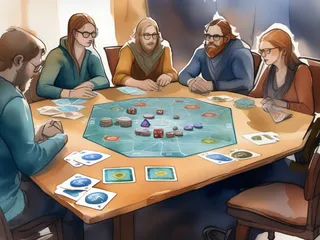Twenty years ago, being a Scrum Master meant you were the keeper of the framework—the person who made sure daily standups happened at 9 AM sharp and that retrospectives followed the prescribed format. Fast-forward to 2025, and if you're still just moving tickets in Jira and asking "What did you do yesterday?"—well, an AI probably does that better than you.
The role has fundamentally shifted, and honestly? It's about time. I've watched this evolution firsthand through economic downturns, remote work revolutions, and the rise of DevOps. The Scrum Masters who survived and thrived didn't just adapt—they transformed themselves into something the original Scrum Guide never envisioned: strategic business enablers who happen to know agile frameworks really well.
From Framework Police to People Champions
Let me paint you a picture of the Scrum Master evolution I've witnessed firsthand:
2005-2010: The Purist Era
- Scrum was new and shiny
- SMs were framework evangelists
- Success = perfect adherence to the Scrum Guide
- "But that's not how Ken Schwaber intended it!" was a common phrase
2010-2015: The Facilitation Focus
- Servant leadership became the buzzword
- SMs learned facilitation techniques
- Success = smooth ceremonies and happy teams
- Still largely process-focused, but with more empathy
2015-2020: The Scaling Challenge
- Agile at enterprise scale became the goal
- SMs started thinking beyond single teams
- Success = multiple teams working in harmony
- Enter SAFe, LeSS, and other scaling frameworks
2020-2025: The Strategic Pivot
- Remote work changed everything
- Business outcomes trumped process adherence
- Success = measurable organizational impact
- SMs became change agents, not just facilitators
The Reality Check: Why Traditional SMs Are Struggling
Here's the uncomfortable truth that many in our community don't want to admit: if your primary value is running meetings and updating boards, you're already redundant.
I've seen talented SMs laid off because their companies realized they could:
- Use AI tools to generate sprint reports and burndown insights
- Automate Jira updates with PowerShell scripts and Azure DevOps pipelines
- Run async standups through Slack bots and Microsoft Teams workflows
- Get retrospective insights from team sentiment analysis tools
- Track velocity and cycle time automatically through Azure DevOps Analytics
The market is brutal right now. Companies are merging Scrum Master and Project Manager roles, eliminating "agile coaches" entirely, and honestly—"agile fatigue" is real. Teams are tired of ceremony for ceremony's sake, especially when half the team is distributed across three time zones.
But here's where it gets interesting (and hopeful): the SMs who are thriving aren't the ones fighting this change—they're the ones embracing it and asking better questions.
What Actually Matters in 2025 (And Beyond)
The Scrum Masters I know who are crushing it right now? They've stopped being process enforcers and started being people amplifiers. Here's what they're doing differently:
1. They Ask Better Questions
Instead of: "Did you complete your story points?" They ask: "What's making this work feel hard right now?"
Instead of: "Are we following the sprint plan?" They ask: "What would help this team deliver more value?"
Instead of: "Why didn't you update your Jira tickets?" They ask: "What's the real blocker here that's making admin work feel overwhelming?"
2. They Understand the Business, Not Just the Backlog
Modern SMs know:
- How their team's work impacts revenue and customer satisfaction
- What keeps their Product Owner up at night (and it's usually not velocity)
- Which metrics actually matter to leadership (hint: it's not story points)
- How to translate technical debt into business language that executives understand
- The difference between leading indicators (deployment frequency) and lagging indicators (revenue)
Real example: A SM I know helped their team identify that fixing a legacy authentication service would reduce customer support tickets by 30%. They didn't frame it as "technical debt cleanup"—they positioned it as "customer experience optimization with measurable support cost reduction."
3. They Navigate Politics with Strategic Influence
Let's be real—organizational change is political, and the best SMs I know don't shy away from this reality:
- They build relationships across departments before they need them
- They know when to push back on unrealistic demands (and how to do it without burning bridges)
- They advocate for their teams without being adversarial
- They understand power structures and work within them strategically
- They document decisions and communicate impact in language leadership values
Here's the playbook I'd run: Start by understanding your organization's actual decision-making process. Who really influences budget decisions? Who sets technical direction? Build those relationships early, because when you need to advocate for your team's capacity or push back on scope creep, you'll need allies, not just agile principles.
4. They Scale Themselves
Instead of just serving one team, they're:
- Coaching other Scrum Masters and creating communities of practice
- Designing organizational improvement experiments with measurable outcomes
- Creating systems and automation that work without their constant intervention
- Teaching teams to self-organize genuinely (not just in theory)
- Building playbooks that other teams can adopt and adapt
The Technical Edge: Tools and Automation
If you want to stay relevant, you need to embrace the tools that are changing the game. The SMs who are winning right now don't just use Jira—they're automating it:
Jira/GitLab/Azure DevOps Integration
- Pipeline success rates as team health indicators
- Deployment frequency tracking
- Lead time measurement from commit to production
- Automated retrospective data collection
Data-Driven Insights
- Cycle time analysis to identify bottlenecks
- Code review time tracking
- Bug escape rate monitoring
- Team sentiment analysis through regular pulse surveys
Bottom line: If you're not comfortable with APIs, basic scripting, and data analysis, you're going to struggle in this new landscape.
Real-World Scenarios: When Theory Meets Reality
Let me share some actual situations I've navigated and how the evolved SM role made the difference:
Scenario 1: The Distributed Team Crisis
Situation: Team spread across 12 time zones, daily standups were useless, async communication was chaos.
Traditional SM Response: "Let's try different meeting times" or "Everyone needs to be more disciplined about Slack updates."
Strategic SM Response:
- Data Analysis: Tracked message response times, identified natural communication clusters
- Tool Innovation: Built PowerShell script to aggregate daily updates from multiple sources (Jira, Git commits, Slack status)
- Process Design: Created "timezone pods" with weekly sync points instead of daily standups
- Measurement: Tracked team velocity and satisfaction scores—both improved 40% over 8 weeks
Key Learning: The framework matters less than the outcome. Don't force ceremonies that don't serve distributed teams.
Scenario 2: The Technical Debt Rebellion
Situation: Engineering team wanted to spend entire sprint on refactoring, Product Owner said absolutely not, tension was building.
Traditional SM Response: "Let's have a conversation in the retrospective" or "What does the Product Owner think?"
Strategic SM Response:
- Business Translation: Calculated the actual cost of technical debt in support tickets and deployment delays
- Risk Assessment: Documented potential business impact of system failures (customer churn, revenue loss)
- Compromise Design: Proposed 70/30 split with measurable outcomes for the technical work
- Executive Influence: Presented business case to leadership with ROI projections
Result: Got buy-in for regular technical debt allocation, improved system reliability by 60%, reduced support tickets by 35%.
Key Learning: Speaking business language gets you a seat at the strategic table.
Scenario 3: The Scaling Nightmare
Situation: Company grew from 2 teams to 12 teams in 18 months, coordination was chaos, delivery was slowing down.
Traditional SM Response: "We need to implement SAFe™" or "Let's have more Scrum of Scrums meetings."
Strategic SM Response:
- Systems Analysis: Mapped actual dependencies between teams (not org chart assumptions)
- Automation Strategy: Built dependency tracking dashboard using APIs available through Jira and GitLab
- Process Architecture: Designed lightweight coordination rituals based on actual need, not framework requirements
- Culture Design: Created cross-team communities of practice for knowledge sharing
Result: Reduced coordination overhead by 50%, improved delivery predictability, teams reported higher autonomy satisfaction.
Key Learning: Scale solutions to actual problems, not theoretical frameworks.
The Psychology of Change: Why SMs Are Uniquely Positioned
Here's something most articles miss: Scrum Masters are actually perfectly positioned for this evolution because you already understand the hardest part—human dynamics.
The Change Management Advantage
You've been facilitating change for years, even if you didn't call it that:
- Resistance patterns: You know how teams react to change and how to work with resistance, not against it
- Group dynamics: You understand how information flows through teams and organizations
- Influence without authority: You've been coaching people who don't report to you—that's pure influence skills
- Conflict navigation: You've mediated between developers and product owners, which is training for stakeholder management
The Systems Thinking Foundation
Every time you've helped a team identify blockers or improve their process, you've been doing systems thinking:
- Root cause analysis: You know how to dig deeper than surface-level symptoms
- Feedback loops: You understand how small changes can create big impacts over time
- Interconnectedness: You see how team dynamics affect delivery, and how delivery affects business outcomes
The Facilitation Superpower
Your facilitation skills translate directly to strategic work:
- Meeting effectiveness: You can run a leadership strategy session as well as a retrospective
- Stakeholder alignment: You know how to get people to agree on next steps
- Decision-making frameworks: You can help executives make better decisions using the same techniques you use with teams
If you want to sharpen these facilitation skills, my guides on Crafting the Perfect Sprint Retrospective and Energizing Your Sprint Retrospectives provide frameworks you can adapt for leadership meetings and strategic sessions.
Building Your Strategic Toolkit
Let's get tactical about building the skills that will keep you relevant:
Week 1-2: Business Literacy Bootcamp
Day 1-3: Read your company's last 3 quarterly reports
- Identify key business metrics leadership cares about
- Understand revenue streams and cost centers
- Note any mentions of technology or operational improvements
Day 4-7: Map your team's work to business impact
- Create a simple spreadsheet linking features to business metrics
- Calculate rough ROI for major initiatives
- Interview your Product Owner about business pressures
Week 2: Shadow customer support or sales calls
- Understand how your product actually gets used
- See what problems customers face
- Identify technical issues that affect customer satisfaction
Week 3-4: Technical Skills Acceleration
API Basics (work with what you have):
- Jira REST API for project data
- Azure DevOps REST API for pipeline metrics
- Slack API for team communication analysis
- Power BI or Excel for visualization
Data Analysis Starter Kit:
- Learn pivot tables in Excel (seriously, master these)
- Basic SQL for querying databases
- Understand correlation vs. causation
- Practice creating compelling visualizations
Week 5-6: Strategic Relationship Building
Map Your Organization:
- Identify key decision-makers beyond your immediate team
- Understand budget approval processes
- Find out who influences technical direction
- Locate the informal power networks
Start Strategic Conversations:
- Schedule coffee chats with people outside your immediate sphere
- Ask about their biggest challenges and priorities
- Offer insights from your team's perspective
- Look for ways to be helpful before you need anything
Week 7-8: Measurement and Communication
Build Your Dashboard:
- Pick 3-5 metrics that matter to leadership
- Create automated reporting where possible
- Design for executive attention spans (1-2 slides max)
- Include narrative, not just numbers
Practice Business Communication:
- Write executive summaries of team retrospectives
- Translate technical challenges into business language
- Create "options and recommendations" formats for decisions
- Practice presenting data-driven recommendations
Common Transformation Mistakes (And How to Avoid Them)
Mistake 1: Trying to Change Everything at Once
What it looks like: Announcing you're now a "strategic business partner" and immediately trying to join executive meetings.
Why it fails: You haven't built credibility in the new role yet.
Better approach: Start small. Pick one business metric, track it consistently, and demonstrate insight over 2-3 months before expanding scope.
Mistake 2: Abandoning the Human Element
What it looks like: Getting so focused on metrics and automation that you stop paying attention to team dynamics.
Why it fails: Your core value proposition—understanding human dynamics—gets lost.
Better approach: Use automation to free up time for deeper coaching and relationship building, not to replace human connection.
Mistake 3: Speaking Only in Business Language
What it looks like: Suddenly talking about ROI and KPIs in every conversation, even with developers.
Why it fails: You lose trust with your team by seeming disconnected from their daily reality.
Better approach: Be bilingual. Speak business language with business stakeholders, technical language with technical teams, human language with everyone.
Mistake 4: Ignoring Organizational Politics
What it looks like: Believing that good ideas will win on merit alone.
Why it fails: Organizations are complex systems with competing priorities and informal power structures.
Better approach: Understand the political landscape and work within it. Build coalitions, find champions, and time your initiatives strategically.
The 90-Day Transformation Plan
If you're serious about evolving your role, here's a practical roadmap:
Days 1-30: Foundation Building
Week 1: Business literacy and stakeholder mapping Week 2: Skill assessment and learning plan creation Week 3: Relationship building and informal research Week 4: Baseline measurement and tool setup
Key Deliverable: A clear understanding of your organization's business priorities and your current skill gaps.
Days 31-60: Capability Development
Week 5-6: Technical skill building (automation, data analysis) Week 7-8: Strategic communication practice and business case development
Key Deliverable: One automated process that saves time and one business case that demonstrates strategic thinking.
Days 61-90: Strategic Integration
Week 9-10: Cross-functional collaboration and influence building Week 11-12: Strategic initiative leadership and organizational impact measurement
Key Deliverable: Measurable organizational impact that you can directly attribute to your strategic work.
The Long Game: Career Paths for Strategic SMs
As you evolve beyond traditional Scrum Master work, several career paths open up:
Path 1: Organizational Development Specialist
Focus: Large-scale culture and process transformation Skills: Change management, organizational psychology, systems design Progression: SM → Senior SM → Agile Coach → OD Consultant → Chief Transformation Officer
Path 2: Product Operations Manager
Focus: Optimizing product development processes and cross-team coordination Skills: Process design, tool integration, stakeholder management Progression: SM → Product Operations → Senior Product Operations → VP of Product Operations
Path 3: Engineering Excellence Manager
Focus: Developer productivity, engineering culture, and technical process optimization Skills: DevOps practices, automation, engineering metrics, technical leadership Progression: SM → Engineering Process Specialist → Engineering Excellence Manager → VP of Engineering
Path 4: Strategic Program Manager
Focus: Complex initiative coordination and strategic execution Skills: Program management, strategic planning, executive communication Progression: SM → Senior PM → Strategic Program Manager → Director of Strategic Initiatives
Tools and Resources for the Modern SM
Essential Software Stack
Communication and Collaboration:
- Microsoft Teams or Slack (with bot integrations)
- Miro or Mural for visual collaboration
- Zoom or Teams for facilitation
Project and Process Management:
- Jira (with extensive automation)
- Azure DevOps or GitHub (for technical teams)
- Monday.com or Asana for cross-team coordination
Data and Analytics:
- Power BI or Tableau for visualization
- Excel with Power Query for data manipulation
- Azure Analytics or Jira Analytics for metrics
Automation and Integration:
- PowerShell or Python for scripting
- Zapier or Power Automate for workflow automation
- REST APIs for custom integrations
Learning Resources
Books:
- "Thinking in Systems" by Donella Meadows
- "The Lean Startup" by Eric Ries
- "Accelerate" by Nicole Forsgren, Jez Humble, and Gene Kim
- "An Elegant Puzzle" by Will Larson
Podcasts:
- Software Engineering Daily
- The Agile Revolution
- Manager Tools
Online Learning:
- Coursera: Data Analysis and Visualization courses
- LinkedIn Learning: PowerShell and business analysis
- Pluralsight: DevOps and cloud technologies
A Personal Note: Why This Evolution Matters
I've been through this transformation myself, and it wasn't always easy. There were moments when I questioned whether I was still a "real" Scrum Master or if I was losing touch with my roots.
But here's what I realized: the heart of being a Scrum Master—helping people and teams thrive—doesn't change. What changes is the scope of impact and the sophistication of the tools.
When I automate a sprint report, I'm not becoming less human. I'm freeing up time to have deeper conversations with team members who are struggling.
When I build a business case for technical debt reduction, I'm not selling out to corporate interests. I'm advocating for my team in language that leadership understands and respects.
When I design organizational experiments, I'm not abandoning agile principles. I'm applying empirical process control at a larger scale.
The evolution from ceremony runner to strategic enabler isn't about becoming someone different—it's about becoming more of who you already are at your best.
The days of hiding behind ceremonies and frameworks are over. The market is demanding strategic thinkers who can drive real organizational change while keeping human well-being at the center.
Remember: Code. Care. Conquer Life. The "care" part—your ability to genuinely help people and teams thrive—that's something no AI can replace. But you need to package that care with strategic thinking and technical competence.
So, what's your next move? Are you going to keep running the same old standups, or are you ready to become the kind of leader your organization actually needs?





